Mirella Sichirollo Patzer's Blog, page 38
July 11, 2012
MY NAME IS HARI. MATA HARI.
The life and times of one of the world’s most famous female spies
by Colin Falconer
Just before dawn on October 15, 1917, a woman was woken by a deputation of religious and turnkeys in the Saint-Lazare prison,
just outside Paris. She was driven to the Vincennes Barracks where a twelve man
firing squad awaited her.
A few moments later Mata Hari was dead.
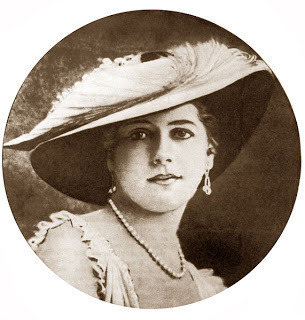
It was the end of
the line for possibly one of the most famous female spies in history.
Mata Hari was
born Gertrud Margarete Zelle. In a society
best known for blonde, blue-eyed women, little M'greet stood apart, with her
thick black hair, black eyes, and olive complexion. She claimed distant
Javanese blood.
Her father was a
successful businessman and M’greet enjoyed a lavish early childhood. But when
she was 13 he went bankrupt. Her parents divorced and when her mother died soon
afterwards she was left in dire straits.
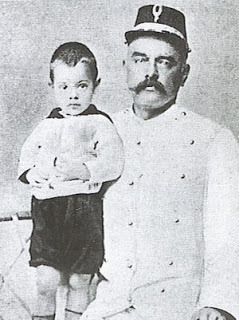
her husband, Rudolf and son, Norman
At 18, she married a Dutch Colonial Army Captain, twenty years her senior, who
went by the unusual name of Rudolf MacLeod. He was posted to Java and there she
bore him two children, Jeanne and Norman-John. But Rudolf was a drinker and a womanizer and the
marriage was unhappy.
Then in 1899, both children fell violently ill in
mysterious circumstances. It was claimed they had been poisoned by an irate
servant though other versions say it was the result of their treatment for syphilis
contracted from their parents - almost certainly Rudolph. Jeanne survived, but Norman died.
The family returned to Holland where M’greet sought a divorce - a scandalous move
for a woman in those days. Rudolf reacted bitterly, putting an advertisement in the
Amsterdam newspapers: "I request all and sundry not to supply goods or
services to my estranged wife Margaretha MacLeod-Zelle."
For a while she sought refuge with various relatives and became a sad
charity case. She had no marketable skills, no husband, no job, and
no income.
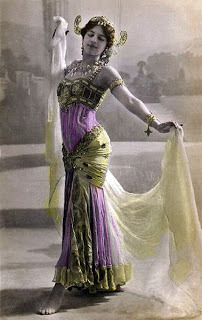
It was in 1905 that she re-invented herself as Mata Hari, (it’s Javanese for
Eye of the Dawn), posing as a Javanese princess, immersed in the art of sacred
Indian dance. After her debut at the Oriental Studies Museum in 1905 she
achieved overnight fame. Think Lady Gaga and Marilyn Monroe.
The most celebrated segment of her act was her progressive shedding of
clothing until she wore just a spangled bra and some jewellery. (She was seldom
seen without a bra as she was self-conscious about her small breasts). ‘My
dance is a sacred poem,’ she told her audiences.
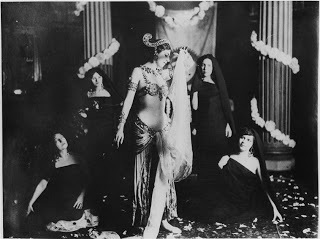
Her sacred, naked poems became outrageously popular with ecstatic audiences
throughout Europe, because what she had done was invent the modern form of striptease.
Naturally, she attracted the attentions of a number of powerful men; high-ranking military
officers, politicians, and aristocrats. These liaisons frequently took her across international borders.
During World War I, she had a passionate May-November romance with a young Russian
pilot who was flying for the French. When he was wounded in 1916 she asked to
visit him at a forward hospital in a neutral zone. French officials at the
Deuxieme Bureau gave her permission - in return for her spying on the Germans.
After all, she had once been the intimate of Germany’s crown prince.
What happened next is unclear. The French later claimed she had already been
recruited by the Germans under the code name H-21 and she was arrested on her
return to Paris in January 1917.
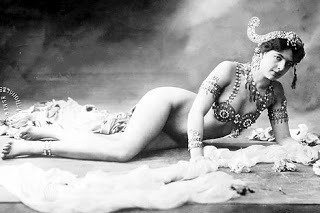
It is interesting to note that French allegations were based on
intercepted messages passed in a code that the Germans knew had been broken.
Germany's motive may have been to lure France into killing one of their own or because
she was truly a double agent.
But it is also suspicious that the French prosecutor asked to hold the trial
"in camera" (in secret) and to seal the records "for the good of
national security." The motion was granted and the huge crowd who had shown up
for the proceedings were shooed out of the courtroom.
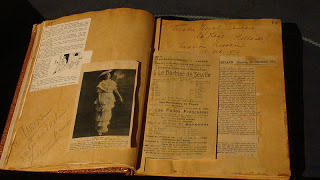
her scrapbook from Fries Museum, Leeuwarden
Under the military trial rules of the time, the defence could not
cross-examine the prosecution's witnesses or even question its own. So the guilty
verdict was a foregone conclusion.
Her execution by the French may have been a serious miscarriage of
justice. Perhaps she was no double agent at all.
Yet she remains one of the most famous spies in history, because of
her stage act. Just the idea of an exotic dancer using her
powers of seduction to extract military secrets from her many lovers fired the
popular imagination. The 1931
film starring Greta Garbo was pure fiction; her name has endured not because
she was such a great spy, but because men liked spying on her.
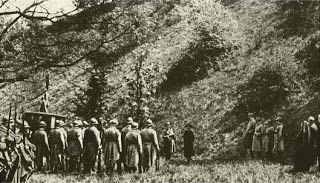
the execution of Mata Hari from a 1921 film
Even after her death, her mystery endured. After a threat by the French government to close
the Museum of Anatomy in Paris in 2000, it was discovered her head had
disappeared from a collection of mummified heads of victims of the firing
squad and guillotine.
The court file cannot be opened before the 15 October 2017, exactly one
hundred years after her execution. This might finally shed some light on the actual
truth.
Until then we can only guess whether Hari, Mata Hari, should be remembered
as The Spy Who Loved Me or The Stripper Who Loved Everyone.
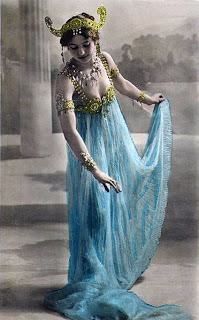
Or perhaps the truth is even more poignant; having dragged herself
single-handed from abandonment and destitution, here was a remarkable woman who
achieved fame and fortune on her own terms, and justifiably felt she no longer owed any
loyalty to anyone.
They say that at the end she refused a blindfold and blew a kiss to the
twelve man firing squad: it seems she ended her days as she lived them -from Java, with
Love.

See Colin Falconer's latest novel, Anastasia, here,
and more history from Colin Falconer at
LOOKING FOR MR GOODSTORY
I LOVE COMMENTS

From History and Women









Published on July 11, 2012 18:09
July 10, 2012
Barbara Palmer, Duchess of Cleveland
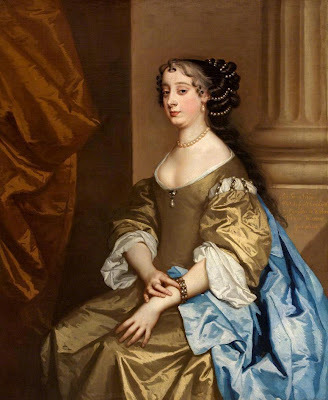
Barbara, Lady Castlemaine, Duchess of Cleveland
Samuel Pepys once found himself in the Privy-garden where he
“saw the finest smocks and linnen petticoats of my Lady Castlemaine’s, laced with rich lace at the bottom, that ever I saw; and did me good to look upon them”. He may have been enthralled by her looks, but when she left her husband, Roger Palmer, Pepys says “I know well enough she is a whore”.
A Viscount's daughter, Barbara was already married when she met Charles soon after his return to England in 1660. When Charles' future queen, Catherine of Braganza arrived from Portugal in 1662, Barbara appears to have been heavily pregnant by the king. She gave birth to a son on 18 June, five weeks after Catherine's arrival. That same day, the Queen visited Barbara in her apartment at Hampton Court, and was so shocked to see the newborn child, she threw a fit and had to be carried out.
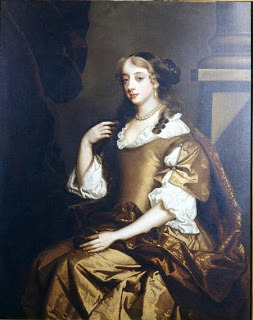
Louise de la Keroualle, Duchess of Portsmouth
Charles had a dichotomous attitude towards Barbara. Although she was never faithful to her royal lover, the King used to visit her four nights a week at her apartments in Whitehall. When her second son was born in 1663, Charles denied paternity but nevertheless, gave Barbara lavish Christmas presents the same year. The couple had ferocious arguments and Barbara was not above threatening Charles. When she was expecting another child in 1667, Barbara swore that if he denied paternity again, she would dash the infant's brains out. Her power over Charles was such that he went down on his knees to be 'pardoned' for his very well-founded suspicions.
Her first daughter, Anne, was initially accepted by her cuckold husband Roger Palmer. It' a credit to Barbara's persuasive powers that the King acknowledged the child as his, but it was more likely that Philip Stanhope, 2nd Earl of Chesterfield was also a prospective father. However, Charlotte, her third child, was undoubtedly the King's.
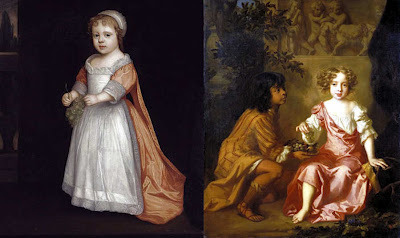
Lady Anne Fitzroy [Palmer] and Lady Charlotte Fitzroy
Ultimately, Barbara's demands were so great, her temper so fierce, and her infidelities so brazen that Charles tired of her. Her rival, Louise de Keroualle conspired to get her removed from court. When Barbara announced she had converted to Catholicism, this was the ideal excuse to have her removed.
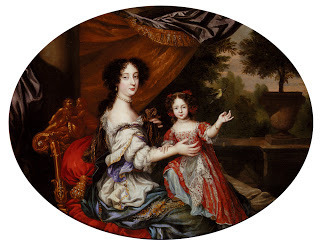
Barbara Countess Castlemaine and her daughter Charlotte Fitzroy
She left for Paris in the spring of 1677, to embark on more liaisons which produced yet more children until she had seven, fathered by at least six different men. Her husband was, apparently, not one of them.
I LOVE COMMENTS

From History and Women









Published on July 10, 2012 03:00
July 7, 2012
Fatal Beauty
Fatal Beauty by Lisa J. Yarde
While the modern age may seem
to be taking beauty rituals to the extreme with the use of Botox, implants and
other cosmetic treatments, women have always resorted to dangerous methods of
making themselves lovelier and more attractive. As an author of historical
fiction, I've enjoyed researching the beautification steps women of the past undertook and finding historical parallels of the risks women take today.
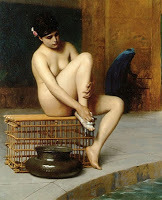
Jean-Leon Gerome's Femme Nue
(public domain)
During the Ottoman Empire, the female
occupants of the Sultan's harem vied to hold their masters' hearts with a
variety of rituals that increased beauty. Rusma
is a depilatory, a mixture of caustic lime (a corrosive element) and orpiment,
a by-product of arsenic. Turkish women applied rusma all over their bodies to remove all hair. After a quick rinse
in the Turkic bathhouse, they used a bronze scraper to remove the mixture. It
had the effect of whitening the skin, but if left on for longer than necessary,
rusma could cause painful burns as it
corroded the skin.

Atropa Belladonna
In Renaissance Italy, the counterparts
of Ottoman women used belladonna to appear more attractive. Belladonna is Italian for beautiful lady. Native
to Europe, belladonna is one of the most toxic plants in the world, also called deadly nightshade. Italian
women refined an extract from the berries of atropa belladonna, as part of their beautification. With
one drop in both eyes, belladonna dilated their pupils, simulating the natural
state of arousal where a person's pupils dilated. Prolonged use of belladonna
caused permanent blindness, but before the onset of it, many women also
experienced increased heart rates and prolonged blurred vision as constant
complaints.

John Singer Sargent's
Mrs. Ralph Curtis (public domain)
The Victorian era introduced another dangerous ritual. Uppper class women mixed
white arsenic, vinegar and chalk to consume or rub on their skins to improve
their complexions and reduce the natural wrinkling of aging skin. It had the
effect of whitening their skin, but arsenic is a potent poison, known from
ancient times as the weapon of choice among nobility and royalty for
dispatching rivals permanently. Ingesting it consistently resulted in
absorption into the blood stream. Deaths sometimes resulted from organ failure.
These rituals give new meaning to the term, “fatal
beauty.”
I LOVE COMMENTS

From History and Women










While the modern age may seem
to be taking beauty rituals to the extreme with the use of Botox, implants and
other cosmetic treatments, women have always resorted to dangerous methods of
making themselves lovelier and more attractive. As an author of historical
fiction, I've enjoyed researching the beautification steps women of the past undertook and finding historical parallels of the risks women take today.

Jean-Leon Gerome's Femme Nue
(public domain)
During the Ottoman Empire, the female
occupants of the Sultan's harem vied to hold their masters' hearts with a
variety of rituals that increased beauty. Rusma
is a depilatory, a mixture of caustic lime (a corrosive element) and orpiment,
a by-product of arsenic. Turkish women applied rusma all over their bodies to remove all hair. After a quick rinse
in the Turkic bathhouse, they used a bronze scraper to remove the mixture. It
had the effect of whitening the skin, but if left on for longer than necessary,
rusma could cause painful burns as it
corroded the skin.

Atropa Belladonna
In Renaissance Italy, the counterparts
of Ottoman women used belladonna to appear more attractive. Belladonna is Italian for beautiful lady. Native
to Europe, belladonna is one of the most toxic plants in the world, also called deadly nightshade. Italian
women refined an extract from the berries of atropa belladonna, as part of their beautification. With
one drop in both eyes, belladonna dilated their pupils, simulating the natural
state of arousal where a person's pupils dilated. Prolonged use of belladonna
caused permanent blindness, but before the onset of it, many women also
experienced increased heart rates and prolonged blurred vision as constant
complaints.

John Singer Sargent's
Mrs. Ralph Curtis (public domain)
The Victorian era introduced another dangerous ritual. Uppper class women mixed
white arsenic, vinegar and chalk to consume or rub on their skins to improve
their complexions and reduce the natural wrinkling of aging skin. It had the
effect of whitening their skin, but arsenic is a potent poison, known from
ancient times as the weapon of choice among nobility and royalty for
dispatching rivals permanently. Ingesting it consistently resulted in
absorption into the blood stream. Deaths sometimes resulted from organ failure.
These rituals give new meaning to the term, “fatal
beauty.”
I LOVE COMMENTS

From History and Women









Published on July 07, 2012 09:51
July 4, 2012
L-O-L-A LOLA
The Life and Times of the Inimitable Lola Montez
by Colin Falconer
She was one of the most notorious women of the Victorian era. She was
undressed by kings and saw some things that a woman ain’t supposed to see.
She even
inspired a popular nineteenth century catchphrase: ‘Everything Lola wants, Lola
gets!’
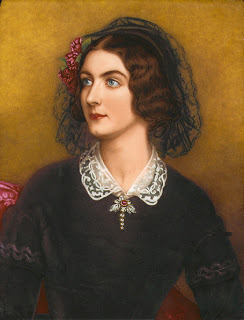
She could shoot, she could dance and she took a horse whip to anyone she
didn’t like. She even brought down a German monarch.
And all before menopause.
She was born Eliza Gilbert, in County Sligo, Ireland in 1821. She went to
boarding school in Scotland where she soon made an impression on her teachers
who described her as an elegant and graceful child, with eyes of ‘excessive
beauty’ and an ‘orientally dark’ complexion.
They also noted a violent temper
and a stubborn streak.
At 16, Lola eloped with one Lieutenant Thomas James. They did not live
happily ever after. Five years later Tom sued her for divorce, citing adultery.
It was granted on the condition that neither party ever married again.
So barely in her twenties, she was already a woman with a past; an elopement,
an adultery and a divorce meant that she could never hope for anything like a
normal life in Victorian England. Her solution was as eccentric as it was
unexpected. She took herself off to Spain to learn the flamenco. Eliza Gilbert,
disgraced wife, re-invented herself as Lola Montez, exotic dancer.
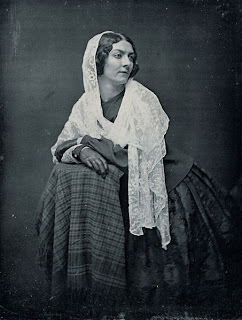
She premiered her erotic Tarantula Dance - it was her own invention - at Her
Majesty's Theatre in London in 1843. But her disguise did not fool some, and when
she was outed as the former Mrs James (ex-Army trollop) she was hounded out of
Britain and fled into the arms of an admirer - Prince Heinrich of Thuringia, in
Germany.
He was to be the first in a long line of Prince Charmings. Thanks to his patronage, she soon became a
favorite in European court circles, performing for the Emperor of Russia and
the King of Prussia among others.
It’s a pity that while taking flamenco classes, she didn’t also sign up for
anger management 101. While in Berlin she horse-whipped a police officer
who had the temerity to try and remove her from a royal parade field.
Things
went from bad to Warsaw when she went to Poland, where her stage performance almost
caused a riot. She was placed under house arrest and then threatened the
policeman sent to guard her with a dagger.
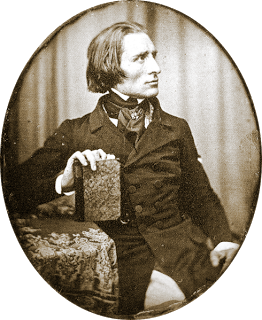
Undeterred, she embarked on a rhapsodic affair with Franz Liszt. Typically
for someone with a quick temper, she lost her composer.
In 1844 it was on
to Paris, and the next in her long line of lovers, newspaper editor Alexandre
Henri Dujarier. After he died in a pistol duel, she took the arm of Alexandre Dumas Pere, author of 'The Three
Musketeers.'
Two years later she headed for Bavaria, thinking to earn some spending money
performing in the Munich Oktoberfest. But when the State Theatre told Lola her
dancing might cause moral offence, she appealed the decision to King Ludwig of
Bavaria himself. The King was far less concerned about offending public morals, as
we shall soon see, and allowed her to debut in a play called, fittingly, 'The
Enchanted Prince.'
Her next major role was as his mistress.
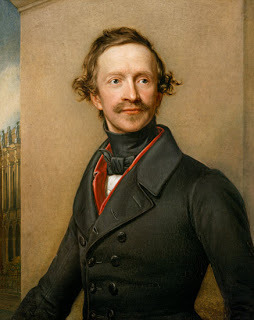
Ludwig built Lola
a palace and named her the Countess of Landesfield. Some even called her the
uncrowned queen.
But she was no Princess Diana; arrogant and haughty, Bavarians
saw her as Princess Uncharming. Ludwig's
relationship with her contributed in no small measure to his fall from grace. As hatred for Lola grew, Ludwig's entire cabinet resigned and after a
revolution in 1848, the King also abdicated.
Lola returned to London.
Never one to mope, she married George Trafford
Heald. a young army officer with a recent large inheritance.
But the marriage broke the conditions of her divorce, and Lola again had to
flee Britain for France or face life behind bars. She and Heald ran up huge
debts in Paris. Well, Lola did. George fled back to England.
She went to America, and in San Francisco she married Patrick Hull, a
local newspaperman. But that marriage soon went out of circulation too.
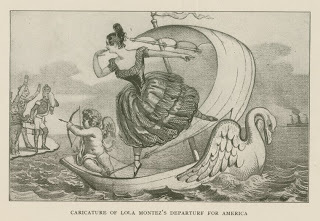
She tried to revive her career by entertaining miners during the Victorian
gold rush in Australia. In September 1855 she performed her erotic Spider Dance
at the Theatre Royal in Melbourne.
Next day the Argus thundered that her performance was 'utterly
subversive to all ideas of public morality'. After reading another bad review
in The Ballarat Times, she attacked the editor, Henry Seekamp, with a horse
whip.
She ended her days in New York. On 30 June 1860, she suffered a stroke which
left her partially paralyzed. By Christmas Day she had recovered enough to hobble
outside for a breath of fresh air but the chill air gave her pneumonia and she died
a month later.
And so ended the life of one of the nineteenth century’s most
astonishing and enigmatic women. Defying the conventions of her age, Lola lived
a riotous and passionate life utterly on her own terms.
She is buried in Green
Wood Cemetery in Brooklyn beneath a tombstone inscribed
Mrs Eliza Gilbert - a name she never used. As a final insult it gives her age
as 42 - she was only 39.
Lucky for the
engraver she wasn’t around to correct him. She would have taken the horsewhip
to him.
What is also missing from her headstone is a suitable epitaph for such a remarkable woman. It might well
have been.
Everything Lola wants - Lola gets.

See Colin Falconer's latest novel, Anastasia, here,
and more history from Colin Falconer at
LOOKING FOR MR GOODSTORY
I LOVE COMMENTS

From History and Women









Published on July 04, 2012 16:58
July 3, 2012
Movie Review: LES ADIEUX A LA REINE
Foreign film- Language: French
RATING: 1 Star
This movie by Benoit Jacquot, is an adaptation of the book:
Farewell My Queen, by Chantal Thomas.
It’s the story of the beginning of the Revolution centered on a private
part of Marie Antoinette’s life, seen through the eyes of Sidonie Laborde, the
queen’s reader.
Sidonie, played by Lea Seydoux, is an almost
non-existent servant and reader. She
dedicates herself wholeheartedly to the queen and wishes nothing more than to
serve her. Nothing is learned about her life, or her past (until the very
end). When not working for the queen, Sidonie
is busy trying to get information on the imminent Revolution. Her last
assignment is mandated by the queen. She is tested to prove her loyalty; that
part being the only somewhat significant part of the movie. Throughout, Sidonie
fails to show any likeability and so unfortunately, no connection can be felt
for this character.
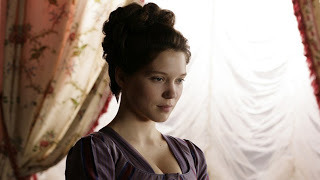
For those interested in factual history, this is probably
not the movie for you. To begin with, Sidonie, is a fictional character, and
the whole ‘behind the scenes’ of Marie Antoinette’s more than friendly love for
la Duchesse de Polignac is the center and all of this movie.
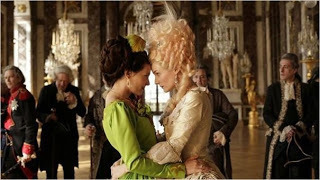
If Sidonie is unlikeable- the same is even truer for Marie Antoinette, played by Diane
Kruger. The French queen is portrayed as
malignantly as she was in the ‘libelles’ of the time. Her role seems fitting to the rumours concocted
about her. Her homosexual preference for la Duchesse is the only focal point of
the movie. And, unfortunately, there is nothing charismatic or endearing about
this self-serving Marie Antoinette.

Mme. De Polignac, the very beautiful Virginie Ledoyen, says
very little throughout the movie. She is
uptight, regal-and has an extremely austere demure. If you’re looking for deep dialog, you won’t
get it from de Polignac- for the most part she’s almost always completely
silent.
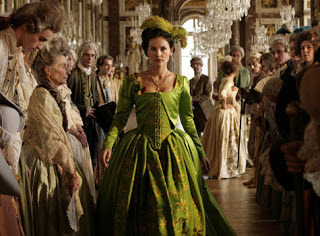
The beauty of luxurious Versailles in the 18thc
is only caught at a glimpse (solely in the room of mirrors-pictured above). The
servant’s quarters, their cavernous eating area, the dingy hallways- were the
main settings. Marie Antoinette’s room
is briefly visited. The only beautiful
scene worth noting, is the one where Marie Antoinette is standing with her
children bidding Louis farewell by the Versailles gates. Sadly, that is the only time we see her
children at all.
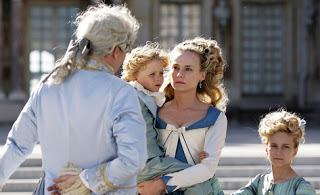
Versailles’ fashion failed to excite as well. (And to think that Rose Bertin is also in
this picture!) Both period costumes and coiffures seemed borrowed from rental
outlets (Marie Antoinette, fashion icon of all times wearing a cheap wool-looking-crooked wig??).
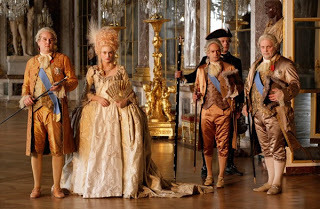
A carousel of secondary
characters made their brief appearances if only to give hope for some
development to the plot; which unfortunately never emerged. The movie went on and on to finally becoming
pointless…
A cold, calculating, shallow and self-absorbed Marie
Antoinette in a less than fairy tale palace, served by an invisible reader
without a cause… Les adieux a la reine is most definitely not what would be
expected- not even, if only, the glitter or the glamour. At the very end there is a hope for climax
where you feel like something will finally happen-and at that very same moment the
words ‘La fin’ appear. Too little, too
late- empty and gone.
NOTE: Being a
Marie Antoinette aficionado, I just had to go see this movie. Unlike my book reviews where I can put aside
a book I don’t like and not review it at all (due to the time I would have to
invest for something I don’t care for)- an hour and a half of my time out with
my daughter is still time well spent no matter how bad the movie was! So I
thought I’d share my thoughts with you; even if they’re negative. And if you love Marie Antoinette as much as I
do, I bet that even after the bad review, you will probably still go out to
watch this. I know, I can
relate- because that's exactly what happened to me!
I LOVE COMMENTS

From History and Women









Published on July 03, 2012 14:25
July 1, 2012
eBook Giveaway - A Cure for the Condition by Amy Croall
eBook Giveaway and a sneak peak at an exciting historical novel, A Cure for the Condition by Amy Croall. All you have to do to enter is leave a comment.

Excerpt:
“The
true man wants two things: danger and play. For that reason he wants woman, as
the most dangerous plaything.”
Friedrich
Nietzsche
Part 1
November
Chapter 1
A forlorn, soft piano melody enveloped
her as the book lay at an awkward angle in her lap. As her eyes remained
closed, absorbing the musician’s brilliant performance, she had no idea her step-brother
was watching her.
“Ah, Princess Catherine—there you are!” he said, barging into the room as he
had many times over the previous two years.
Princess Catherine inhaled before his gravelly voice could release her
daydreams. Sitting straight on the stiff sofa in the parlor, she placed the
book next to her.
“Yes, good afternoon, Malcolm,” she replied.
Malcolm supplied her with a half-smirk and proceeded to lean against the sofa
on which she sat. Princess Catherine couldn’t help but experience an
ever-so-slight tingle when she peered into his crystal-blue eyes.
Although her step-brother’s nose was somewhat too large, his lips thin, and his
face angular, Malcolm had a strong jaw, well-groomed silver hair, and a smile
that could draw women from countries away. At times, his boyish half-smirk made
it difficult for Princess Catherine to recall he was seven years her senior.
“I heard about your meeting with the suitor this afternoon, and I must say I am
intrigued,” he said.
Catherine donned an immediate scowl. “Malcolm, is this going to be another
instance such as when you barged into this room as I was learning that piano
and tell me I am causing a ruckus, or will it be reminiscent of when I returned
home wearing rouge and you mocked me endlessly?” she demanded.
Malcolm feigned ignorance, putting a hand to his heart. “Why, dear step-sister,
I am saddened by your accusations! I merely wished to extend my…condolences
that the meeting did not go as hoped.” He suppressed a half-hearted chuckle.
“Of course,” Catherine replied, clearing her throat. “I’ll have you know our
feelings were requited. I did not much care for the man.”
“Oh? That’s not what was told to me. I was told he stifled a laugh at first
sight of you, and then appeared bored and lazy the remainder of his stay,”
Malcolm said, pulling on a lock of Catherine’s brown hair.
She pulled away and supplied him with a sharp stare.
“My, my, you certainly are a harbinger of rejection, aren’t you? Inquiring
minds are dying to know, Princess—what’s that like?” he asked.
“I suppose you should ask the multitude of women at your feet, Malcolm; perhaps
they would be a more fitting choice. Tell me, how many with whom have you
been?” she demanded, attempting to quell the sting of emotion forcing its way
through her middle.
Malcolm stopped for a moment and furrowed his brow. “I don’t know; I don’t
count,” he replied smugly, turning his attention back to her.
“Of course not.”
“Oh, poor Catherine,” he continued. “No man will ever desire to be the Prince
of a woman as plain as you. Why, your ridiculous freckles and mousy brown hair
will never draw in a man of merit.”
Catherine inhaled a sharp breath and straightened her back. “How dare you! I am
an educated woman, I speak three languages fluently, and I am heir to the
Cannary throne!”
“Oh come now, you’re seventeen and still have yet to find a husband. How many
suitors does that man make, anyway?”
At his words, Catherine stood and clenched her fists at her sides. “I will not
stoop to your level of…affectionate teasing, Malcolm!”
For a moment, her step-brother said nothing, seeming to be surprised by her
sudden outburst. However, after regaining his composure, he was hit with a fit
of laughter so powerful he was forced to double over and clutch his belly.
“Affectionate! Oh, you are much too entertaining!” he said between chuckles.
Wanting no more of his belligerent behavior, Catherine stormed from the parlor
and down the hall to the Queen’s study, the familiar twinge of despondency
trying to force tears from the well behind her eyes.
“Princesses do not cry!” she told herself before knocking on her mother’s door.
Once she heard the unmistakable soft voice of her mother granting her entrance,
she pushed the door open and barged into the room.
“Oh, Catherine, dear!” her mother said, a warm smile on her face. She pushed
aside a pile of papers and supplied her daughter with her full attention. “I
apologize about that abysmal meeting between you and Mr. Elgar this afternoon.”
“It is fine, Mother,” Catherine replied, seating herself in a plush chair
across from the large maple desk at which the Queen worked. She straightened
her back and folded her hands in her lap.
“You must understand that I feel you are at an age where you must find a
husband.” The Queen smiled again, gentle wrinkles creasing into the skin around
her eyes and mouth.
“It is no bother, Mother. However…”
Queen Victoria leaned forward, awaiting her daughter’s next words. “What is it,
dear?”
“Well...there is this...man…” she stumbled with unease.
“Ah ha!” her mother cried, standing from her desk. “I knew it! I would recognize
that look anywhere!”
“Mother, please…”
“Nonsense! Why did you not tell me of this man sooner?” Queen Victoria
demanded, rounding the corner and embracing her daughter.
“He does not share my feelings,” Catherine replied with a sigh. With purpose,
she omitted the fact that this man was also her step-brother.
Her mother pulled away and looked deep into her daughter’s emerald eyes. “Any
man who does not find you perfect is utterly mad,” she said with a smile.
Catherine returned her mother’s gesture with a strained smile of her own. “But,
I am convinced he is the only man I desire, Mother.”
The Queen took a seat in the other plush chair adjacent to her large desk and
sighed.
“Catherine, I’d like to tell you a story,” she began.
The Princess nodded and allowed her mother to continue.
“When I was not much younger than you, I married your father. I believed he was
the handsomest man in the world. I doubted I would ever find another love such
as he gave me. But…” she paused, a frown creasing into her long face, “when he
died...well...I was torn, you know this.”
“Yes, but I would rather not speak of Father,” Catherine replied, her voice tight
with decade-old anger.
“Of course, I understand. At any rate, when I met Malcolm’s father two years
ago, my belief in love was renewed; Callum is a wonderful man. Catherine, I am
sure one day you will find a man who will return all the affection and love you
hold in your heart.”
*
* * *
After a late supper that night,
Catherine was studying her books in a small den across from the castle’s
dungeon. Many of the words and phrases in the books were familiar to the
Princess, and she found herself submitting to a brief chuckle at the Cannary
License Act of 1872, which prohibited civilians to operate bovine while
intoxicated.
Soon, as often happened on late nights when studying, she found herself
intimidated by a particular clause in one of Cannary’s oldest policies. Placing
a piece of parchment between the pages to mark her place, she stood from the
plush sofa and made her way down the hall toward the bedroom of the Queen and
Prince.
“Mother?” she called, knocking on the door.
Silence followed, so the Princess rapped again.
“Mother?” she said with more force.
When no one answered, she turned the brass door handle and peeked into the
room. What she saw was unimaginable.
Blood was spattered on the painting of her great grandfather and the pink
striped wall above the four-poster bed. The sheets were soaked with the sticky
red substance as it dripped off of the bed skirt into a puddle on the floor.
The Queen and Prince of Cannary lay motionless, bathed in the crimson fluid.
Catherine stared unmoving at the scene before her in utter terror.
Her lungs froze as she tried to call for help. All her prior schooling and
instincts left her as she stared at her mother and step-father’s lifeless
bodies before her. She was unable to remember whom she was to call in a
situation such as this. At last, when her head began to swim, she pulled in a
labored breath and opened her mouth.
“Malcolm!”
Her step-brother was the first person who had come to mind, and she shouted his
name with all the strength left in her body.
By chance, his room was just across the hall and he emerged a moment later,
raking a hand through his tousled silver hair.
“For what reason are you shouting, Catherine?” he demanded, yawning wide.
“Moth...mother…” she stuttered.
Malcolm let out a sigh and trudged across the hallway to Catherine’s side. She
was vaguely aware of his presence, but couldn’t tear her gaze away from her
poor mother.
After what seemed like an eternity of silence, Malcolm pushed Catherine away and
pointed down the hallway.
“Go, Catherine! Go to your room! Whoever’s done this may still be here!” he
shouted at her.
Startled by the force of his voice, Catherine’s composure returned, and she
scampered toward the end of the long hall, followed by her step-brother’s
shouts for the guards.
[image error]

About
Amy Croall
I was born in Santa Maria, a small town
close to Santa Barbara, California. The town was small, dusty, and my parents
did not have a lot of money. I spent my adolescence reading and furthering my
education in any way I could. I often spent my vacations buried in books or
doing writing of my own. Ultimately, it was my father who got me excited about
the power of writing. He and I would write short children's stories about ducks
and frogs playing in the swamp. One day, we collaborated an idea about writing
a picture book in which animals lived in harmony with humans.
When I was eighteen, I moved out of my
parents' house and took creative writing and literature classes. When I met my
husband, he encouraged me to write for myself, but I had higher aspirations.
With A Cure for the Condition, I had
my first professional success with Whiskey Creek Press and was able to spend
more time learning the ins and outs of writing. For my second book A Cure for the Past, I researched with a
concept designer at NASA. At the moment, I am working on submitting The Death of Me to agents and am
planning the subsequent novels in its wake.
www.amycroall.com
www.amycroall.blogspot.com
www.amazon.com/author/amycroall
I LOVE COMMENTS
 From History and Women
From History and Women










Excerpt:
“The
true man wants two things: danger and play. For that reason he wants woman, as
the most dangerous plaything.”
Friedrich
Nietzsche
Part 1
November
Chapter 1
A forlorn, soft piano melody enveloped
her as the book lay at an awkward angle in her lap. As her eyes remained
closed, absorbing the musician’s brilliant performance, she had no idea her step-brother
was watching her.
“Ah, Princess Catherine—there you are!” he said, barging into the room as he
had many times over the previous two years.
Princess Catherine inhaled before his gravelly voice could release her
daydreams. Sitting straight on the stiff sofa in the parlor, she placed the
book next to her.
“Yes, good afternoon, Malcolm,” she replied.
Malcolm supplied her with a half-smirk and proceeded to lean against the sofa
on which she sat. Princess Catherine couldn’t help but experience an
ever-so-slight tingle when she peered into his crystal-blue eyes.
Although her step-brother’s nose was somewhat too large, his lips thin, and his
face angular, Malcolm had a strong jaw, well-groomed silver hair, and a smile
that could draw women from countries away. At times, his boyish half-smirk made
it difficult for Princess Catherine to recall he was seven years her senior.
“I heard about your meeting with the suitor this afternoon, and I must say I am
intrigued,” he said.
Catherine donned an immediate scowl. “Malcolm, is this going to be another
instance such as when you barged into this room as I was learning that piano
and tell me I am causing a ruckus, or will it be reminiscent of when I returned
home wearing rouge and you mocked me endlessly?” she demanded.
Malcolm feigned ignorance, putting a hand to his heart. “Why, dear step-sister,
I am saddened by your accusations! I merely wished to extend my…condolences
that the meeting did not go as hoped.” He suppressed a half-hearted chuckle.
“Of course,” Catherine replied, clearing her throat. “I’ll have you know our
feelings were requited. I did not much care for the man.”
“Oh? That’s not what was told to me. I was told he stifled a laugh at first
sight of you, and then appeared bored and lazy the remainder of his stay,”
Malcolm said, pulling on a lock of Catherine’s brown hair.
She pulled away and supplied him with a sharp stare.
“My, my, you certainly are a harbinger of rejection, aren’t you? Inquiring
minds are dying to know, Princess—what’s that like?” he asked.
“I suppose you should ask the multitude of women at your feet, Malcolm; perhaps
they would be a more fitting choice. Tell me, how many with whom have you
been?” she demanded, attempting to quell the sting of emotion forcing its way
through her middle.
Malcolm stopped for a moment and furrowed his brow. “I don’t know; I don’t
count,” he replied smugly, turning his attention back to her.
“Of course not.”
“Oh, poor Catherine,” he continued. “No man will ever desire to be the Prince
of a woman as plain as you. Why, your ridiculous freckles and mousy brown hair
will never draw in a man of merit.”
Catherine inhaled a sharp breath and straightened her back. “How dare you! I am
an educated woman, I speak three languages fluently, and I am heir to the
Cannary throne!”
“Oh come now, you’re seventeen and still have yet to find a husband. How many
suitors does that man make, anyway?”
At his words, Catherine stood and clenched her fists at her sides. “I will not
stoop to your level of…affectionate teasing, Malcolm!”
For a moment, her step-brother said nothing, seeming to be surprised by her
sudden outburst. However, after regaining his composure, he was hit with a fit
of laughter so powerful he was forced to double over and clutch his belly.
“Affectionate! Oh, you are much too entertaining!” he said between chuckles.
Wanting no more of his belligerent behavior, Catherine stormed from the parlor
and down the hall to the Queen’s study, the familiar twinge of despondency
trying to force tears from the well behind her eyes.
“Princesses do not cry!” she told herself before knocking on her mother’s door.
Once she heard the unmistakable soft voice of her mother granting her entrance,
she pushed the door open and barged into the room.
“Oh, Catherine, dear!” her mother said, a warm smile on her face. She pushed
aside a pile of papers and supplied her daughter with her full attention. “I
apologize about that abysmal meeting between you and Mr. Elgar this afternoon.”
“It is fine, Mother,” Catherine replied, seating herself in a plush chair
across from the large maple desk at which the Queen worked. She straightened
her back and folded her hands in her lap.
“You must understand that I feel you are at an age where you must find a
husband.” The Queen smiled again, gentle wrinkles creasing into the skin around
her eyes and mouth.
“It is no bother, Mother. However…”
Queen Victoria leaned forward, awaiting her daughter’s next words. “What is it,
dear?”
“Well...there is this...man…” she stumbled with unease.
“Ah ha!” her mother cried, standing from her desk. “I knew it! I would recognize
that look anywhere!”
“Mother, please…”
“Nonsense! Why did you not tell me of this man sooner?” Queen Victoria
demanded, rounding the corner and embracing her daughter.
“He does not share my feelings,” Catherine replied with a sigh. With purpose,
she omitted the fact that this man was also her step-brother.
Her mother pulled away and looked deep into her daughter’s emerald eyes. “Any
man who does not find you perfect is utterly mad,” she said with a smile.
Catherine returned her mother’s gesture with a strained smile of her own. “But,
I am convinced he is the only man I desire, Mother.”
The Queen took a seat in the other plush chair adjacent to her large desk and
sighed.
“Catherine, I’d like to tell you a story,” she began.
The Princess nodded and allowed her mother to continue.
“When I was not much younger than you, I married your father. I believed he was
the handsomest man in the world. I doubted I would ever find another love such
as he gave me. But…” she paused, a frown creasing into her long face, “when he
died...well...I was torn, you know this.”
“Yes, but I would rather not speak of Father,” Catherine replied, her voice tight
with decade-old anger.
“Of course, I understand. At any rate, when I met Malcolm’s father two years
ago, my belief in love was renewed; Callum is a wonderful man. Catherine, I am
sure one day you will find a man who will return all the affection and love you
hold in your heart.”
*
* * *
After a late supper that night,
Catherine was studying her books in a small den across from the castle’s
dungeon. Many of the words and phrases in the books were familiar to the
Princess, and she found herself submitting to a brief chuckle at the Cannary
License Act of 1872, which prohibited civilians to operate bovine while
intoxicated.
Soon, as often happened on late nights when studying, she found herself
intimidated by a particular clause in one of Cannary’s oldest policies. Placing
a piece of parchment between the pages to mark her place, she stood from the
plush sofa and made her way down the hall toward the bedroom of the Queen and
Prince.
“Mother?” she called, knocking on the door.
Silence followed, so the Princess rapped again.
“Mother?” she said with more force.
When no one answered, she turned the brass door handle and peeked into the
room. What she saw was unimaginable.
Blood was spattered on the painting of her great grandfather and the pink
striped wall above the four-poster bed. The sheets were soaked with the sticky
red substance as it dripped off of the bed skirt into a puddle on the floor.
The Queen and Prince of Cannary lay motionless, bathed in the crimson fluid.
Catherine stared unmoving at the scene before her in utter terror.
Her lungs froze as she tried to call for help. All her prior schooling and
instincts left her as she stared at her mother and step-father’s lifeless
bodies before her. She was unable to remember whom she was to call in a
situation such as this. At last, when her head began to swim, she pulled in a
labored breath and opened her mouth.
“Malcolm!”
Her step-brother was the first person who had come to mind, and she shouted his
name with all the strength left in her body.
By chance, his room was just across the hall and he emerged a moment later,
raking a hand through his tousled silver hair.
“For what reason are you shouting, Catherine?” he demanded, yawning wide.
“Moth...mother…” she stuttered.
Malcolm let out a sigh and trudged across the hallway to Catherine’s side. She
was vaguely aware of his presence, but couldn’t tear her gaze away from her
poor mother.
After what seemed like an eternity of silence, Malcolm pushed Catherine away and
pointed down the hallway.
“Go, Catherine! Go to your room! Whoever’s done this may still be here!” he
shouted at her.
Startled by the force of his voice, Catherine’s composure returned, and she
scampered toward the end of the long hall, followed by her step-brother’s
shouts for the guards.
[image error]

About
Amy Croall
I was born in Santa Maria, a small town
close to Santa Barbara, California. The town was small, dusty, and my parents
did not have a lot of money. I spent my adolescence reading and furthering my
education in any way I could. I often spent my vacations buried in books or
doing writing of my own. Ultimately, it was my father who got me excited about
the power of writing. He and I would write short children's stories about ducks
and frogs playing in the swamp. One day, we collaborated an idea about writing
a picture book in which animals lived in harmony with humans.
When I was eighteen, I moved out of my
parents' house and took creative writing and literature classes. When I met my
husband, he encouraged me to write for myself, but I had higher aspirations.
With A Cure for the Condition, I had
my first professional success with Whiskey Creek Press and was able to spend
more time learning the ins and outs of writing. For my second book A Cure for the Past, I researched with a
concept designer at NASA. At the moment, I am working on submitting The Death of Me to agents and am
planning the subsequent novels in its wake.
www.amycroall.com
www.amycroall.blogspot.com
www.amazon.com/author/amycroall
I LOVE COMMENTS
 From History and Women
From History and Women








Published on July 01, 2012 15:12
June 29, 2012
Mrs Robinson’s Disgrace: The Private Diary Of A Victorian Lady by Kate Summerscale
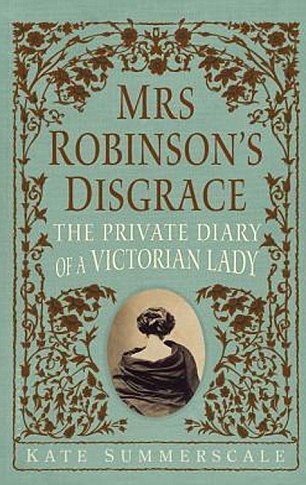
Summary
"I think people marry far too much; it is such a lottery, and for a poor woman--bodily and morally the husband’s slave--a very doubtful happiness." - Queen Victoria to her recently married daughter Vicky.
Headstrong, high-spirited, and already widowed, Isabella Walker became Mrs. Henry Robinson at age 31 in 1844. Her first husband had died suddenly, leaving his estate to a son from a previous marriage, so she inherited nothing. A successful civil engineer, Henry moved them, by then with two sons, to Edinburgh’s elegant society in 1850. But Henry traveled often and was cold and remote when home, leaving Isabella to her fantasies.
No doubt thousands of Victorian women faced the same circumstances, but Isabella chose to record her innermost thoughts-and especially her infatuation with a married Dr. Edward Lane-in her diary. Over five years the entries mounted-passionate, sensual, suggestive. One fateful day in 1858 Henry chanced on the diary and, broaching its privacy, read Isabella’s intimate entries. Aghast at his wife’s perceived infidelity, Henry petitioned for divorce on the grounds of adultery. Until that year, divorce had been illegal in England, the marital bond being a cornerstone of English life.
Their trial would be a cause celebre, threatening the foundations of Victorian society with the specter of "a new and disturbing figure: a middle class wife who was restless, unhappy, avid for arousal." Her diary, read in court, was as explosive as Flaubert’s Madame Bovary, just published in France but considered too scandalous to be translated into English until the 1880s.
As she accomplished in her award-winning and bestselling The Suspicions of Mr. Whicher, Kate Summerscale brilliantly recreates the Victorian world, chronicling in exquisite and compelling detail the life of Isabella Robinson, wherein the longings of a frustrated wife collided with a society clinging to rigid ideas about sanity, the boundaries of privacy, the institution of marriage, and female sexuality.
Review
Mrs Robinson’s Disgrace is a non-fictional accounting of Victorian woman’s diary and her secret love. Isabella Robinson was an upper middle class woman married to a successful businessman with whom she had three children. One could say Isabella had it all – a wealthy husband, plenty of servants, plenty of fashionable clothes and accessories, and the perfect family.
Despite all this, Isabella was not happy. She was trapped in a loveless marriage with a difficult, cold man who was away from home most of the time. He had two illegitimate children, a sign that his own moral values were corrupt. Her unhappiness led to Isabella falling hopelessly and lustfully in love with Dr Edward Lane, the son-in-law of a family within her closest social circle. In a secret diary, Isabella diligently recorded her innermost feelings, desires, and thoughts as her passion for the married Dr Lane turned into obsession. As her marriage failed and led to divorce, her diary was used against her by her infuriated husband and mocked for its scandal in the media at the time. Her husband had stolen the diary and used it against her in his divorce suit on the grounds of her adultery. The case culminated in a choice for Mrs Robinson to declare herself sexually active and immoral or insane. She chose to be labelled immoral and be disgraced, thus erasing any moral after-effects on Dr Lane and his family.
This book provides readers with an accurate depiction of how difficult and complex life for Victorian women was and the dilemmas they faced in matters of sexuality and married life. Excerpts of the diary are interspersed in in the factual, historical accounting of this famous case. All in all, it is a fascinating case story and an important historical event worth reading about.
I LOVE COMMENTS

From History and Women









Published on June 29, 2012 14:01
June 27, 2012
DEDICATED FOLLOWERS OF FASHION
What were some of the strangest - and sometimes most dangerous - fashion trends that women have followed through history?
Here's a brief look.
1. SKIRTING WITH DANGER
One of the memorable moments of Gone with the Wind was watching Scarlett and the other southern belles flaunting themselves in enormous hoop skirts. Hoop skirts have been variously fashionable throughout history; in Scarlett's day, the hoops were actually a massive cage of steel
or stiff fabric called crinoline worn under a skirt to keep it in shape.
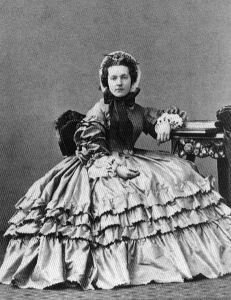
But
this was perilous fashion. The hoop skirt was susceptible to wind
gusts; there are stories of women being swept out to sea, with the
crinoline acting as a sort of sail. There were other perils; they could
get caught in carriage wheels and were unwieldy indoors. Poet Henry
Wadsworth Longfellow's second wife knocked over a candle with her skirt
and went up in flames
In Chile in 1863, between two and three thousand people
died in a church fire when women in huge hoop skirts piled up in front
of the exit, making it impossible for anyone to get out.
2. THE BATTLE OF THE BULGE
The
corset was more like an instrument of torture than a fashion device.
Used as an artificial means of staving off a gym membership, the device
was made doubly unpleasant for the wearer if it was tight laced. Some
women suffered acutely for their artificial abs and a heaving bosom.
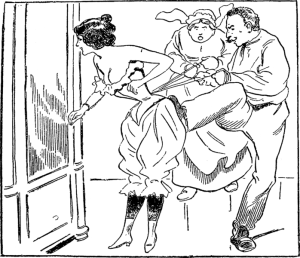
In fact in 1903, a Mrs Mary Halliday of Niagara Falls woman even died when two pieces of corset steel snapped and lodged in her heart.
But
mostly they just caused incredible discomfort, as can happen when your
liver is relocated somewhere behind your
collarbone for a few hours of high society.
The only wonder, for these dedicated followers of fashion, is that feminism took so long to arrive ...
3. LETS GO CHOPINE
The chopine was
a type of platform shoe popular during the Renaissance, used as a sort
of overshoe to protect a lady’s real shoes and dress from the mud and
ordure that littered the streets back in the day.
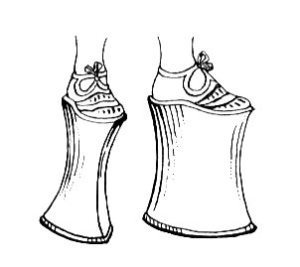
They
became particularly fashionable among the courtesans of Venice. They
were made of wood or cork and covered with brocade or velvet. But the
fashion got out of hand; shoes became a status symbol, would you
believe! The higher the heel, the further up the social ladder you were.
Some were over twenty inches high. A woman could literally tower over her competitors.
Women wearing chopines were often accompanied by a servant on whom they could lean; though the Italian dancing master Fabritio Caroso wrote that a proper
lady should be able to dance flourishes and galliards with them on.
Really? I would think it was like trying to dance a tango in stilts.
4. DEAD BUT WITH A GREAT COMPLEXION
Lead
was the cosmetic of choice from the times of ancient Greece right up to
the twentieth century, I’m afraid. It gave the wearer a fetchingly pale
complexion but turned the blood culture into something you’d expect to
find at Chernobyl or Bhopal. It also damaged the skin; the only solution
was to put on more lead on it to cover it up.
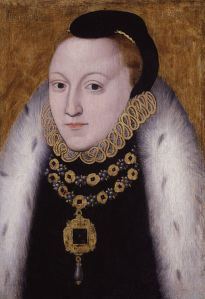
Elizabeth I, looking suitably pale
It
takes years to accumulate to a fatal dose. Victims literally pale into
insignificance. Meanwhile they put up with minor side effects like brain
damage, paralysis, insomnia, and curiously, a limp wrist.
The most celebrated death from lead poisoning is believed to be Elizabeth the First.
5. THE CLEOPATRA LOOK
Why
do the folk you see on the walls of ancient Egyptian walls wear so much
eye make up? Were they all trying to look like Kim Kardashian?
Actually,
it just helps reduce glare. The Egyptians not only had to cope with the
bright desert sun but the pyramids and other public buildings were
originally covered in stark white limestone (you can only see this
veneer today at the very apex of the Giza pyramids) so every time they
went outside it was like walking into a row of searchlights.

But yes, it also looked great on Elizabeth Taylor. She just wore it to reduce the glare, too.
6. MY FEET ARE KILLING ME
Footbinding
produced the so-called ‘lily’ feet or ‘lotus’ feet once common in
China. Women today may complain about high heels but this was probably
one of the cruellest forms of foot torture ever invented. What were they
thinking? Perhaps the Chinese saw what the Inquisition were doing in
Europe and felt envious.('We want a Spanish boot too! ... Only let's put
it on the women.)
Footbinding first became fashionable China in around the eighth century and persisted for almost a thousand years. Women were literally crippled by this custom.
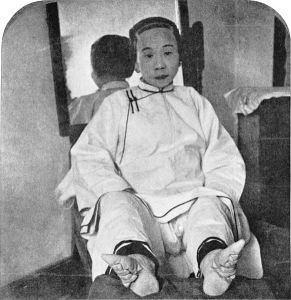

A
noble woman in Imperial China with normal feet was practically
unmarriageable. (Only peasants had normal feet, because they needed to
get about in the fields and work. A real lady showed her status by
staggering around in agony or having someone carry her.)
While
still a small child a rich girl had her feet soaked in a bath of urine
and vinegar, then all the toes except the big one were folded under the
foot, and secured with tight bandages. This soaking and binding process
would continue throughout the girl’s childhood, with the result that the
feet never grew more than three inches long.
Often
this disgusting procedure led to gangrene; this was considered a good
thing as the rotting toes would then fall off and cease being a
nuisance! The ideal of perfection was to have hardly any foot at all.
Chinese
men loved women with lily feet, even though the feet themselves were
usually covered in silk slippers. And a good thing, too; under the
bandages they were often a rotting, scabrous mess and stank to high
heaven. One fashion trend we don’t want back.
That, and flares.

See Colin Falconer's latest novel, Anastasia, here,
and more history from Colin Falconer at
LOOKING FOR MR GOODSTORY
I LOVE COMMENTS

From History and Women









Published on June 27, 2012 10:24
June 19, 2012
The Queen's Vow by C.W. Gortner
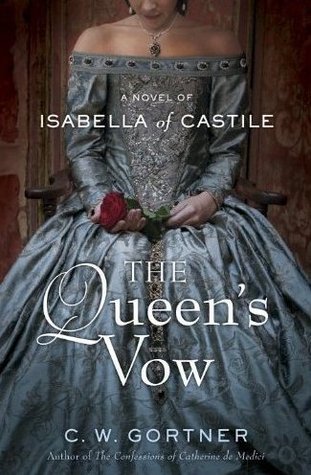
Synopsis
No one believed I was destined for greatness... So begins Isabella’s story, in this evocative, vividly imagined novel about one of history’s most famous and controversial queens—the warrior who united a fractured country, the champion of the faith whose reign gave rise to the Inquisition, and the visionary who sent Columbus to discover a New World.
Acclaimed author C. W. Gortner envisages the turbulent early years of a woman whose mythic rise to power would go on to transform a monarchy, a nation, and the world.
Young Isabella is barely a teenager when she and her brother are taken from their mother’s home to live under the watchful eye of their half-brother, King Enrique, and his sultry, conniving queen. There, Isabella is thrust into danger when she becomes an unwitting pawn in a plot to dethrone Enrique. Suspected of treason and held captive, she treads a perilous path, torn between loyalties, until at age seventeen she suddenly finds herself heiress of Castile, the largest kingdom in Spain. Plunged into a deadly conflict to secure her crown, she is determined to wed the one man she loves yet who is forbidden to her—Fernando, prince of Aragon.
As they unite their two realms under “one crown, one country, one faith,” Isabella and Fernando face an impoverished Spain beset by enemies. With the future of her throne at stake, Isabella resists the zealous demands of the inquisitor Torquemada even as she is seduced by the dreams of an enigmatic navigator named Columbus. But when the Moors of the southern domain of Granada declare war, a violent, treacherous battle against an ancient adversary erupts, one that will test all of Isabella’s resolve, her courage, and her tenacious belief in her destiny.
From the glorious palaces of Segovia to the battlefields of Granada and the intrigue-laden gardens of Seville, The Queen’s Vow sweeps us into the tumultuous forging of a nation and the complex, fascinating heart of the woman who overcame all odds to become Isabella of Castile.
Review

Queen Isabella
The Queen’s Vow is a biographical novel about the life of Queen Isabella of Castile who married Prince Ferdinand of Aragon in the 15th century.

Ferdinand and Isabella
Isabella makes an intriguing heroine, strong, determined, savvy when confronted with the numerous political intrigues, decisions and responsibilities she faced. As a young woman, she manoeuvres her way through court plots and cold-hearted enemies until a stroke of fortune/misfortune makes her the official heiress to Castile. The novel spans most of her life and includes both the good decisions and bad decisions this tough woman made – from starting the Inquisition to funding Christopher Columbus’ expedition to discover the new world.
The author paints a softer version of this fascinating woman than history has depicted. He does an excellent job of demonstrating some of the emotional turmoil she experienced when making hard decisions or trying to protect her people. Isabella definitely walked a fine line between King Enrique, the Catholic Church, and the many Jews or Conversos in Spain. The novel also delves into descriptions of her family, other historical persons, and physical surroundings with astounding detail.
I always know I'm settling down for a rich read when I pick up any of Christopher Gortner’s novels. And this one was no exception. He is highly knowledgeable in the Renaissance period and this comes through strongly in this latest novel. The beautiful prose, blended with bountiful detailed descriptions, make this novel a delight to read. His uncanny ability to delve deep into the thoughts of the historical figure he writes about is what truly brings to life his main characters.
If you have never read one of C.W. Gortner’s novels, then this is a good one to start with. Queen Isabella was the mother of Juana, the main character in another of Gortner’s novels, The Last Queen. And don’t forget to pick up The Confessions of Catherine de Medici! He truly is a talented author with a knack from bringing these famous women to life. Very Highly recommended.
I LOVE COMMENTS

From History and Women









Published on June 19, 2012 08:19
June 18, 2012
Anastasia Romanov
Today, June 18th, 2012
would have been the 111th birthday of one of the most fascinating women
of recent history – Anastasia Romanov.
To celebrate her birthday, Sourcebooks
has kindly offered to give away a copy of The Last Romanov by Dora Levy Mossanen. The giveaway is open to all residents of Canada and the U.S. To enter, read the following biography and leave your thoughts. The most poignant comment, the one that touches my heart the most, will win the book.
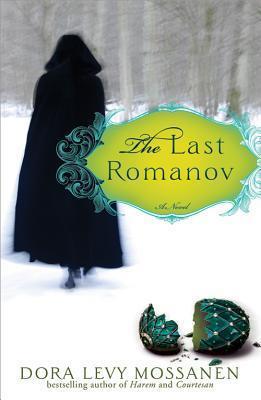
The story of Anastasia Romanov is
one of the most heart-wrenching stories ever told; it is about the horrific fate that she and her
family suffered during the Bolshevik Revolution. To this day, the tragedy still
resurrects doubt as to what exactly happened to the young Grand Duchess of Russia.
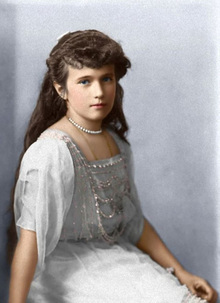
Anastasia Romanov
Anastasia was born into great
wealth and privilege in the late spring of 1901. She came into the world amid the
opulence of a vast palace in St. Petersburg, Russia. She was the youngest of
four daughters born to Nicholas II and his wife Aleksandra.
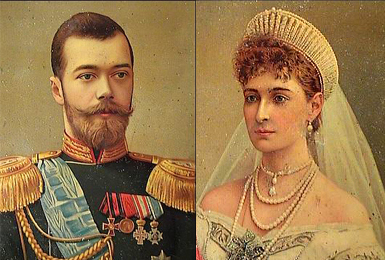
Nicholas Aleksandra
After four daughters, at long last, several later, a son, the future heir to the throne of Russia, was born to the handsome couple.
Vigorous and energetic, Anastasia
was well loved as a child. She and her siblings were close-knit and spent all their time
together. Despite their royal status, the children were not overly pampered or
spoiled. In fact, they adhered to strict royal protocols and faced a rigid
daily schedule for their schooling and meals. They spent their evenings
together with Nicholas reading to them. Sometimes their aunt organized small balls
to help the children prepare them for their future responsibilities.
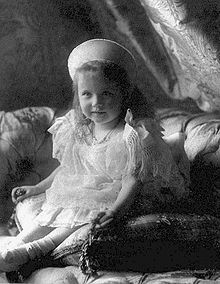
Anastasia as a young child
Always rambunctious and active,
Anastasia did not enjoy the confines of the school room. Science and numbers and
figures confounded her. Spelling and grammar bored her and seemed to difficult
to master. The drudgery of school work competed with her desire for fun and
pranks and frolic. She preferred the outdoors where she could escape to hide in
a tree or play. She possessed a strong competitive spirit to the point where
she would not hesitate to do anything to win, even if it meant cheating or
harming an opponent.
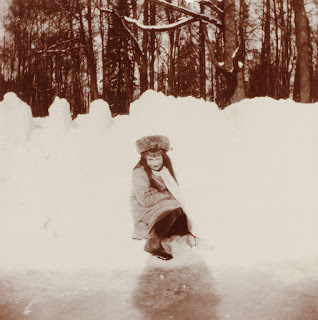
Small Anastasia was a cheerful child
with a great sense of humor. A tomboy at heart! She loved her brother Alexy and
they often entered into great acts of mischief together.
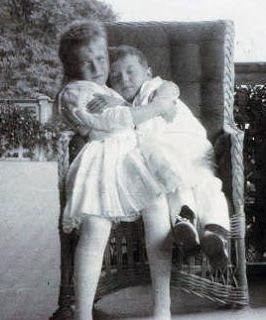
Anastasia and Alexei
Ever the spirited one,
Anastasia indulged her fondness for chocolate and her favourite Pomeranian named
Shvibzik. As she became older, she even began to secretly smoke and spent entire
days reading novels.
One day, Aleksandra met a man
named Grigory Rasputin. From that day onward, he was integrated into their
daily lives. Anastasia was especially enchanted with the principled, elderly
man. To him she confided her secrets, the yearnings of her heart. Their
friendship was one of mutual trust and great respect. So all encompassing was
their relationship, that her tutor complained about Rasputin to the Tsar and
Tsarina. The tutor was fired and Rasputin’s standing in the family remained.

Grigory Rasputin
Meanwhile, rumours and gossip about
the family’s strange relationship with Rasputin spread through the realm. Tsar
Nicholas’ siblings voiced the greatest displeasure. Reluctantly, Nicholas sent
Rasputin away to put a little distance between them. Unfortunately, shortly
thereafter, Rasputin was murdered. Poor Anastasia grieved long and hard at the
death of her good friend and mentor.
World War I brought many changes
into their lives. Their beautiful palace became a hospital for the wounded. Aleksandra
and her eldest daughters tended the injured in the infirmary. Maria and
Anastasia, too young for such hard work, read or wrote letters on the soldiers’
behalf, entertaining them as best as they could with games or books.
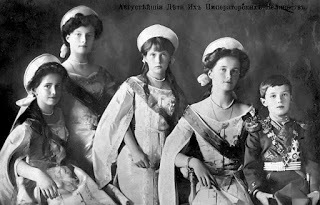
The Romanov Children
In early 1917, Anastasia and her
siblings contracted measles, and it was while they were convalescing that the
first of the family’s troubles began. Nicholas was away from home. The masses
in Russia were revolting. Rebels had surrounded the palace. A fearful Aleksandra
kept the truth from her children, explaining the armed soldiers outside as mere
military exercises.
One month later, Aleksandra received
the news that her husband had abdicated the throne. The rebels took the Romanov
family into custody. When Nicholas returned home the family were constrained in
their home, unable to leave for any reason. Outside the palace gates, whenever the
public caught a glimpse of the imprisoned royals, they shouted nasty insults to
the royals. Despite all the turmoil, the Romanovs strove to maintain as normal
a life as possible.

That summer, the rebels decided
to transfer the family to Tobolsk in Siberia. The family wished their servants
farewell. After being herded into a train, the family was swept away from their
beloved Saint Petersburg. Life in Tobolsk was restricted and boring. There was
nothing to entertain the children. Soldiers surrounded them at all times. Even so, nothing could restrict the antics of the spirited Anastasia.
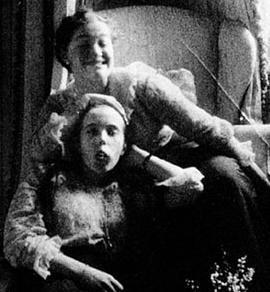
Picture of Maria with Anastasia sticking out her tongue at photographer
A year passed. Aleksandra and
Maria accompanied Nicholas to Moscow for his trial. Anastasia and her other
sisters remained at home to care for their Aleksey who was ill again. Upon
their arrival, they were searched and all valuables were confiscated. While
they waited for the trial, Aleksandra wrote to her children and asked them to hide
the family medicine (a code name for jewels). Anastasia and her sisters sewed
them into their clothing.
Thereafter, Anastasia, her
sisters, and Aleksey were sent to Yekaterinburg in well-guarded, closed carriages,
to join their parents.
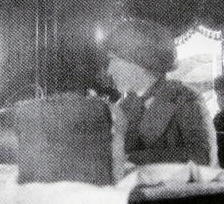
Photo of Anastasia on train to Yekaterinburg.
This is the last known picture of Anastasia before her death
There, they were held under even stricter confinement.
They were not allowed outdoors and were not even permitted to open a window. Ever
the free spirit, and longing for the outdoors, a frustrated Anastasia dared to
swing open a window. A sentry witnessed her act and fired at her, closely
missing her.
The family began to show the
first signs of stress at their severe treatment. Rumour of an alleged plot to
rescue the Tsar began to circulate. This spurred the rebels into action. On the
night of 17 July, sentries woke up the unsuspecting family and herded them all
into the cellar. The made the family sit on the chairs. The girls took their
hand-bags with them, and Anastasia even took Jimmy, her dog. Then the firing
began.
After it was done, many believe
that Anastasia, Maria and Tatiana were still alive – the jewels sewn in their
dresses had saved their lives – and the soldiers had to finish the wounded
girls off by hitting them hard with bayonet caps and butt-stocks. The murderers
then gathered the bodies, wrapped them in bed sheets, and brought them to the
outskirts of the village of Ganina Yama to be buried. The murderers wanted to
keep their burial place a secret, but villagers noticed the grim cavalcade. The
Red Army chased the peasants away, menacing them with guns. At the burial site,
the killers went to work again. This time, to cover their tracks and any
evidence that could identify the members of the Romanov family, they disfigured
their victim’s faces with sulfuric acid, knives, and butt-stocks. Villagers
heard the shell explosions at the ominous location. Others found some jewels
that presumably belonged to the Tsar’s family, left behind by executioners eager
to cover up their horrific crime.
Later, a crime investigators questioned
the locals and ordered the burial site excavated, but the command was countermanded.
Rumors that one of the Tsar’s
daughters had managed to escape and stay alive began circulating. Homes, inns, hotels,
barns, trains, and farms were searched, but to no avail.
In 1991, 70 years after the
tragic event, excavations at the suspected burial site commenced. It did not
take long to discover the bodies. They had been buried at little more than one
meter in depth. Most of the bodies were identified, but that of Anastasia could
not be verified. This gave credence to the rumours that she may have survived
the killing. But if this was true, what happened to Anastasia? Where was the
illusive, spirited young woman? Had she truly survived, living a quiet,
unnoticed life somewhere in an obscure village, town, or country?
In the aftermath of the murders,
many “Anastasias” have come forward to lay claim to her name and title. DNA
tests have since disproved their claims. The truth will perhaps never be known.
Wherever she is, I hope that Anastasia has the peace that eluded her in the
last days she spent on earth.
I LOVE COMMENTS

From History and Women









Published on June 18, 2012 04:58



